The 7-Step Process for Successful Proof of Concept Execution

Proof of Concept (PoC) is a crucial step in the development of new products, services, or solutions. It can be used to validate an idea, design, or technology before investing significant time and resources into its implementation.
There are 7 steps that are important to successfully creating a PoC. In this article, we will dive into each one individually.
Step 1: Identify the Parameters
An effective PoC starts with identifying the parameters of the operational business case. Your entire PoC will be measured against these parameters.
To find the parameters that are appropriate for your case:
- Identify the business need. What is the problem that the PoC is intended to address? Be as specific as possible about all the elements of the problem.
- Define the goals of a solution. What do you want the outcome to be? How will this be different from your current situation?
- Determine the success criteria. Will you have increased efficiency, improved customer satisfaction, reduced costs, or increased revenue?
- Identify the stakeholders: Who will be impacted by the PoC? Remember to include both internal and external stakeholders.
- Determine the scope. What is the timeframe, budget, and resources required?
With this information, you will be able to establish all of your parameters and proceed with the next steps of the process.
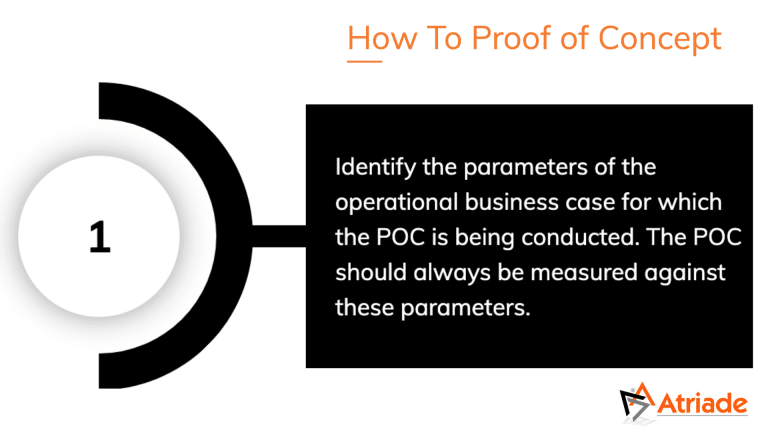
Step 2: Establish What Data is Needed
What data do you need to make the correct business case? It is important to capture both technical and operational data. This will allow you to measure not only the technology’s effectiveness but also the user experience.
The types of data can vary based on the specific project or initiative being tested. Here are some data types to consider:
- Business Data
This includes data related to the business need or opportunity that the PoC is intended to address. It might include sales data, customer data, or financial data.
- Technical Data
What technology is being tested during the process of the PoC? Consider data related to hardware or software components, data storage and retrieval, network performance, or system integration.
- Performance Data
This includes data related to the performance of the PoC, such as data related to response time, throughput, or scalability.
- Operational Data
This includes data related to the operational aspects of the PoC. This could include data related to maintenance and support requirements, training needs, or resource utilization.
- User Data
This includes data related to user behavior and preferences. This could include data related to user interactions with the PoC, user feedback, or user satisfaction.
Refer to the initial information you created when establishing the parameters for the PoC. By doing so, you can determine which elements are important to track and measure for the most accurate results.
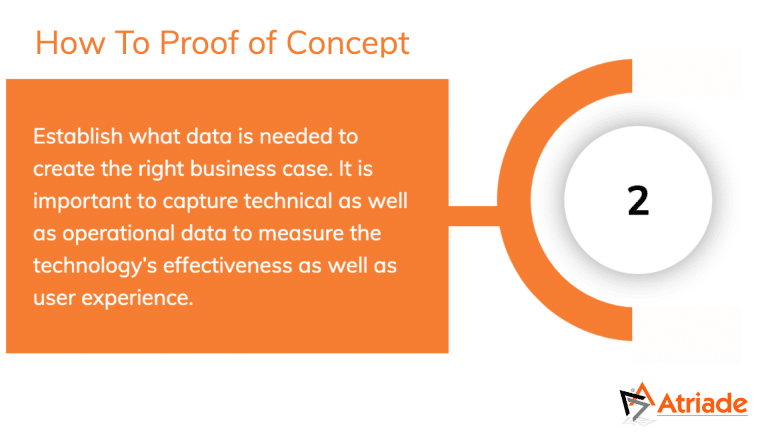
Step 3: Create Your POC Environment
Creating a PoC environment is your next step in developing and testing a PoC. You want the environment to mimic the production environment as closely as possible. This enables you to test in a controlled and secure environment.
- Define the Requirements
Determine the hardware, software, and network requirements needed to support the PoC such as identifying the necessary hardware components, such as servers, storage devices, and networking equipment.
- Configure the Environment
Install and configure the required software and hardware components in the PoC environment.
- Test the Environment
Test the PoC environment to ensure that it is functioning correctly and meets the requirements. Be sure to include connectivity between different components, testing the performance of the environment, and ensuring that the environment is secure.
- Test the Proof of Concept
Test the PoC in the PoC environment to ensure that it is functioning as expected. Be sure to test the functionality, performance, and security of the PoC.
- Refine the Proof of Concept
Refine the PoC based on the results of the testing. This could involve tweaking the code or configuration, adding, or removing components, or adjusting the environment settings.
- Document the Environment
Document the PoC environment, including the hardware, software, and network components, configurations, and settings. This documentation will be useful in replicating the PoC environment in the production environment.
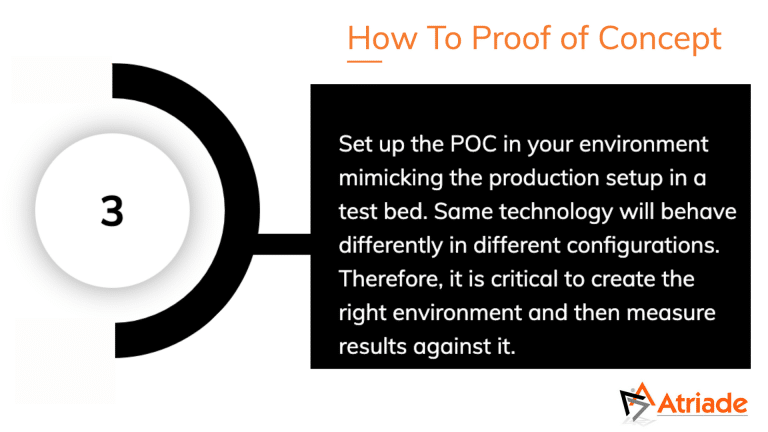
Step 4: Observe Everything
When you are running your PoC, it is vital to not only monitor the core technology, but all the aspects that the PoC impacts. Answers to these observation questions will provide the core of your PoC results:
- Infrastructure
How does this impact the larger ecosystem outside the components directly impacted by the PoC?
- Administration
How will business functionality be impacted?
- Staffing
Whose job functions and roles are impacted and in what ways? Will you need additional people or different roles filled to reach your objectives?
- Architecture
Do you have the right technological components in place?
- Aesthetics
How is user experience changed in your PoC?
- Branding
Do the results align with your big-picture business goals and positioning? Are they in line with your mission and vision?
- Maintenance and Support
Are all the processes, people, and technology in place to ensure that you continue to see the positive results you want over time?
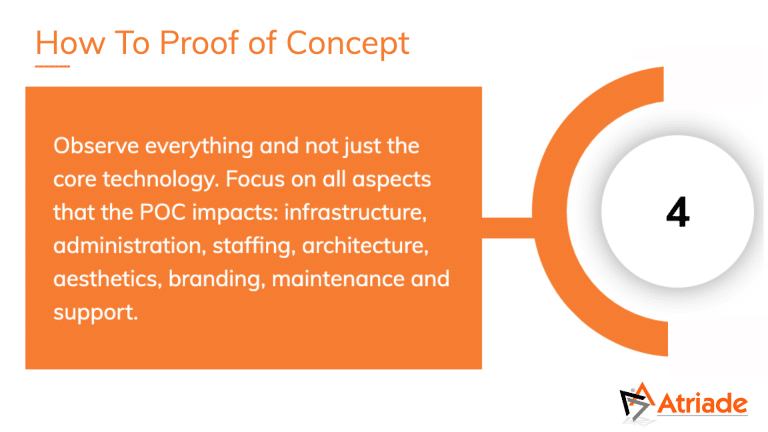
Step 5: Document the POC from Beginning to End
The best PoC test in the world will only be as good as the documentation attached to it. Every part of the evaluation, process, and observation should be included in a clear and organized format. This will be essential for making your case to leadership based on the PoC testing.
Be aware of the following:
- Determine who is responsible for each part of the documentation. How will they measure and record that information?
- What is the structure of the documentation? For example, what should be included in the table of contents, what sections and subsections are important, and how will those relate to the goals of the test?
- How will you determine what the key information is, and how will that be documented?
- Describe the environment, including the hardware, software, and network components used in the PoC, as well as the configuration and settings of these components.
- Capture the process, including the methodology used, the steps taken, and any challenges encountered.
- Include the results. This should include the success criteria, the performance, and the functionality of the PoC. It also must address any issues and how they were resolved.
- Add screenshots and diagrams to make it easier to understand.
Not only will this documentation give you the resources to present your results, but also to replicate the testing and adjust as needed to get to your desired result.
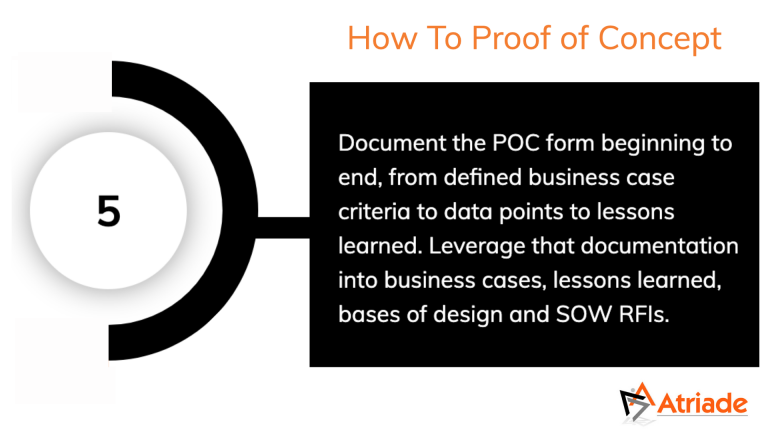
Step 6: Create a Plan That Includes Immediate, Midterm, and Long-term Deployment
Once a PoC has been completed and the results analyzed, the next step is to create a plan based on the PoC that outlines how to move forward with implementing the solution in the production environment.
- Analyze the Results
Analyze the results and determine whether the solution met the objectives and goals outlined in the PoC plan. Identify any issues or challenges that were encountered during the PoC and determine how they can be addressed.
- Develop a Roadmap
Develop a roadmap for implementing the solution based on the results of the PoC. This should include a high-level plan that outlines the major milestones, deliverables, and timelines for the implementation.
- Define the Architecture
Define the architecture of the solution based on the results of the PoC. This includes determining the hardware, software, and network components required, as well as the configuration and settings of these components.
- Develop a Detailed Plan
Include immediate, midterm, and long-term deployment.
- Identify Resources
How does this impact the larger ecosystem outside the components directly impacted by the PoC?
- Develop a Budget
This should include costs for hardware, software, personnel, training, and any other expenses related to the implementation.
Once you have a detailed plan, you will be able to present the solution to leadership and create a process for implementation.
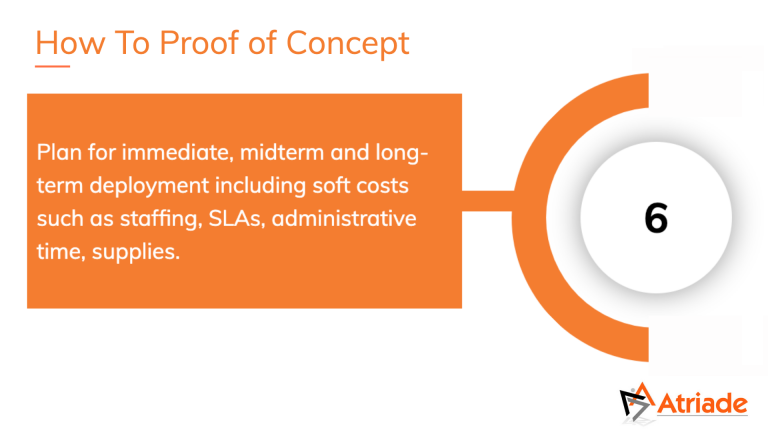
Step 7: Establish Risk Tolerance and Acceptance
The final step in your PoC process is to establish a risk tolerance and acceptance model for a fully informed business case to leadership.
- Define risk tolerance based on the organization’s objectives, goals, and mission, as well as legal and regulatory requirements.
- Evaluate the risks involved in the plan, including the likelihood and impact of each risk.
- Develop risk management strategies to minimize the risk to the organization.
- Establish criteria for determining what is an acceptable risk.
- Include a process for ongoing risk management and evaluation.
Risk can change significantly over time, so developing this section of the plan will ensure that leadership is able to make informed decisions based on the PoC testing, results, and plan.
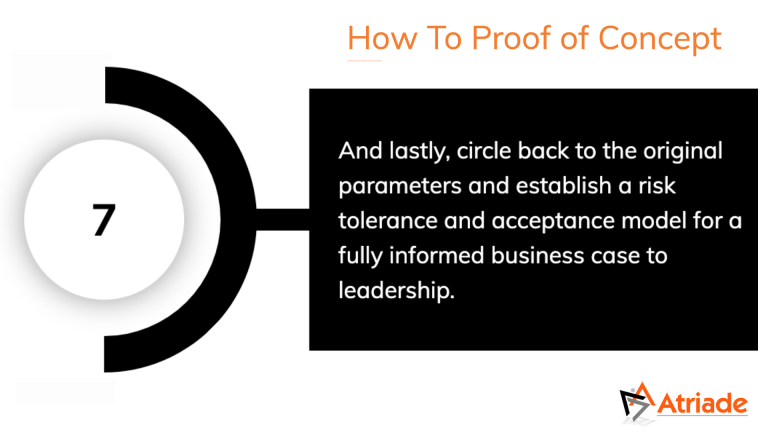
Conclusion
High-quality PoC modeling has the capacity to set a business or organization apart from the competition by enabling the best possible decision-making. Following these best practices can help your organization take advantage of opportunities and avoid pitfalls. Many businesses may not know how to effectively run a PoC. This is one area where additional support from an outside consultant can be helpful.
About Atriade
Atriade has worked on over 500+ projects, in 60+ industries, in 30+ countries. If you are ready to get expert assistance in creating your security masterplan that will set you apart from your competitors, we are here to help. Our management team carries a lifetime of experience in all areas of Physical Security and Electronic Security that we are ready to put to work for your unique business and team.
Visit us online at Atriade.com
Connect with us on LinkedIn
Subscribe to our LinkedIn Newsletter: Take A Risk
- Categories:
- Blog,
- Project Management
